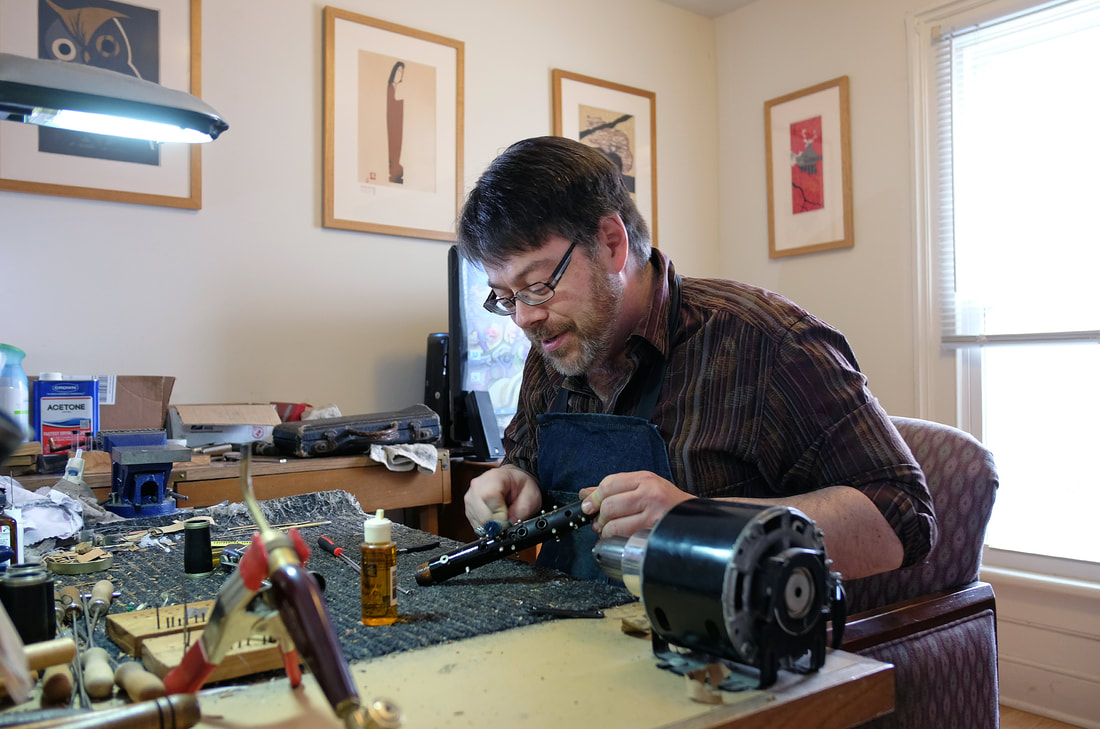|
After years of refurbishing Penzel Mueller clarinets, I'm still amazed at the obscurity in which they linger! From a buying point of view, great: from a selling point of view, not so good. So, here's a little info to pique your interest in this unjustly forgotten brand.
The company was started by 2 German immigrants, Penzel and Mueller, in the early 1890's in Long Island City NY. They offered a variety of clarinets and flutes, as well as some saxes and brass which I suspect were made by someone else and stencilled with the PM logo. If someone can shed more light, please do! The company operated through the late 1950's (as best I can determine), before ceasing production. Their clarinets (especially the Artist, Studio Recording, and Super Brilliante models) were top of the line horns, easily comparable to anything coming out of Europe during the period. Woody Herman played an Artist model, in fact. The tone was more 'American' than 'French' in concept - think Conn rather than Buffet - great for Jazz as well as concert music, freeblowing, more direct than sweet. Intonation is very good on most of the horns I've tried, and the keywork is comfortable unless you have very small hands: there's a bit of a spread, which is welcome for us large fingered folk! A customer in Texas was kind enough to forward a model/price list from their 1955 catalog: Super Brilliante $340 Artist, new model $265 Empire $265 Bel Canto $185 American Professional $165 Soloist $149.50 Dyna-Tone $139.50 Standard Model $129.50 The only one I've worked on that I don't see here is the 'Studio Recording' model, which was a pro horn that came with 3 barrels. Perhaps it had been discontinued by 1955? Anyway, I hope this is enough to get you to keep an eye out for one of the better PM's in good playing condition. Regardless of the style you play, I believe you'd enjoy it.
46 Comments
With the holiday (clarinet) shopping season upon us, it seems like a good time to broach the question; why should you spend your hard earned dollars on a vintage clarinet rather than a new instrument? Here are a few thoughts...
1) The retail markup has already been paid: Instead of $600 for a new plastic or $1800+ for a new wood instrument, how about $400-800 for a fully refurbished intermediate or pro quality wood clarinet? The price represents the initial cost of a vintage instrument, shipping, overhaul (buffing, pads, cork, etc), photography, writeup and customer service time. You can speak directly to the technician that restored the instrument, who will take time to answer your questions and find the best horn and mouthpiece for you. Then, you can put the rest of your money back in the bank. 2) Quality materials: Instead of a body made of plastic or cheap dyed wood sporting plated, cast metal keys, you'll get grenadilla wood of a quality rarely seen any more and solid nickel alloy keys hand soldered for strength and durability. These old horns were built to last and will give you years of dependable service. 3) Quality construction: these horns were built by craftsmen with pride in their work, not just an eye for the bottom line. Many features that were once common, like post locks, solid nickel keywork and fittings, and extra keys to facilitate challenging passages are rarely seen except on the most expensive modern horns. Also, many old horns received more tuning time than modern budget instruments and still play well in tune after many years. I've sold more than a few high end vintage clarinets to players who subsequently sold their modern Buffets after comparing the two... 4) More choices: instead of overpriced Buffets and Buffet clones, there were many fine makes, 50+ years ago, with distinct personalities. Thibouville Freres, SML, Leblanc, Penzel Mueller and many more offered everything from small to extra large bore sizes, custom keywork, and tones from bright to dark and sweet to brazen. Players of Jazz, Klezmer, and various ethnic musics (as well as Classical and commercial) owe it to themselves to experience the range of sounds and feels available with vintage/antique horns and mouthpieces before settling for an expensive, mass produced modern horn. 5) USA made and played: all of these horns were bought/made here, refurbished here, and the money I earn stays here! How many of the big stores (and bigger websites) can say that? We need to move back to American goods and services to revive our economy and I'm happy to help. I could go on, but I think the point is made. Let me know your thoughts, experiences and wishes for the future - please just keep it concise and polite, as this is a public posting.... |
Archives
February 2024
AuthorThe Licorice Shtick Blog is the creation of the Vintage Clarinet Doctor, a Winston Salem, NC based woodwind instrument repair shop specializing in vintage and antique clarinets, saxophones, and the occasional flute. Categories |

 RSS Feed
RSS Feed